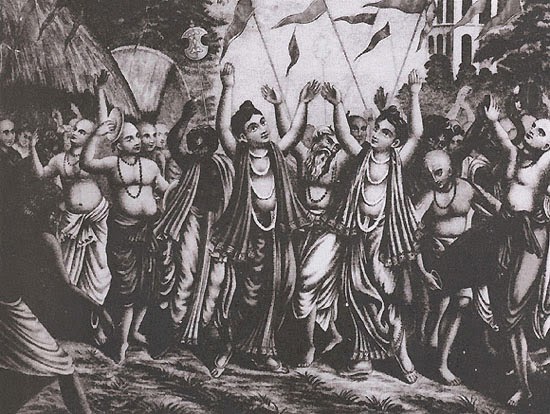“Śrīla Prabhupāda’s Kīrtana Standards,” installment 54

The father of the sankīrtana movement, of course, was Śrī Caitanya Mahāprabhu himself. While Śrīla Prabhupāda and the early London devotees were staying at John Lennon’s estate in Tittenhurst, Mukunda Dāsa (later Mukunda Goswami) asked Śrīla Prabhupāda how Lord Caitanya did kīrtana, back in the sixteenth century. What did the chanting parties look like in those days?
Mukunda Mahārāja relates:
“Yes,” he paused, smiling like he was pleased with my question. He leaned forward as though he was revealing something very private. “Krishnadasa Kaviraja Goswami writes of this in his Chaitanya-caritamrita. There were two mrdanga players, two dancers and seven karatalas. Other people would join, but the main ones—the mrdangas, karatala men and the dancers—they were the center.” He spoke quietly as if telling me a secret.
“The mrdangam players, they would inspire the dancers,” he continued. “And the dancers, they would inspire mrdangas. One person would lead, and the rest, they would respond. Like we do here in temple—lead and respond.” He paused. “In this way, they created ecstatic feelings by chanting the holy names very expertly.”
“When leader chanted, drums and cymbals would play quiet so everyone could hear. Then when everyone sang, drums and karatalas played loud. And when leader sang again, they would play soft again. So soft and loud, they would go on in that way, and repeat.”1
Notes:
1 Miracle on Second Avenue, p. 375‒6. In Caitanya-caritāmṛta, Madhya-lila, Chapter 13, texts 33 through 50, Kṛṣṇadāsa Kavirāja Gosvāmī describes the kīrtana parties Lord Caitanya organized for the Jagannātha Ratha-yātrā. In a letter to Hamsaduta, June 13, 1970, Śrīla Prabhupāda said there should be seven such kīrtana parties for the Ratha-yātrā festival in London and gave further details.

You must be logged in to post a comment.